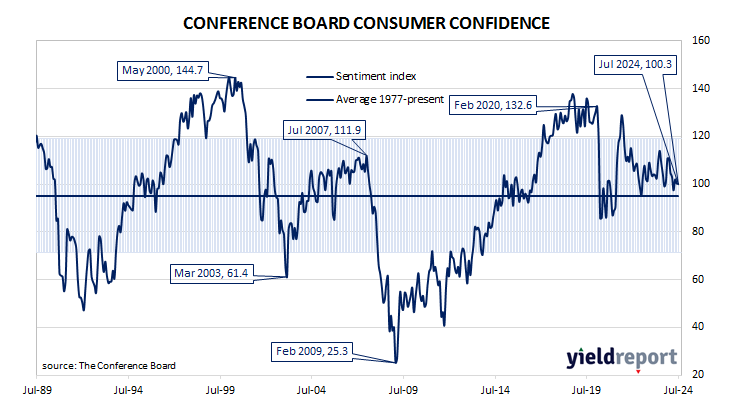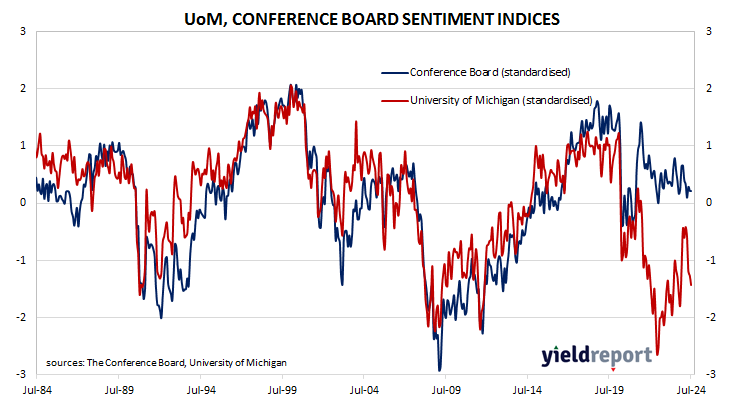Summary: Conference Board Consumer Confidence Index up in July, slightly above expectations; still concerned about elevated prices, interest rates, uncertainty about future; US Treasury yields fall moderately; expectations of Fed rate cuts firm; views of present conditions deteriorates, short-term outlook improves; expectations for future income improves slightly, consumers generally negative about business, employment conditions ahead.
US consumer confidence clawed its way back to neutral over the five years after the GFC in 2008/2009 and then went from strength to strength until late 2018. Measures of consumer confidence then oscillated within a relatively narrow band at historically high levels until they plunged in early 2020. Subsequent readings then fluctuated around the long-term average until March 2021 when they returned to elevated levels. However, a noticeable gap has since emerged between the two most-widely followed surveys.
The latest Conference Board survey completed in the third week of July indicated its measure of US consumer confidence has continued bumping along at near-average levels. The latest reading of the Consumer Confidence Index registered 100.3 on a preliminary basis, slightly above the generally-expected figure of 99.7 and up from June’s final figure of 97.8.
“Even though consumers remain relatively positive about the labour market, they still appear to be concerned about elevated prices, interest rates and uncertainty about the future, things that may not improve until next year,” said Dana Peterson, Chief Economist at The Conference Board.
The report was released on the same morning as the latest JOLTS report and US Treasury yields fell moderately across the curve on the day. By the close of business, 2-year and 10-year Treasury bond yields had both shed 4bps to 4.36% and 4.14% respectively while the 30-year yield finished 3bps lower at 4.40%.
In terms of US Fed policy, expectations of a lower federal funds rate in the next 12 months firmed, with at least five 25bp cuts currently factored in. At the close of business, contracts implied the effective federal funds rate would average 5.315% in August, 2bps less than the current spot rate, 5.205% in September and 4.915% in November. June 2025 contracts implied 4.00%, 133bps less than the current rate.
Consumers’ views of present conditions deteriorated while their views of the near-future improved. The Present Situation Index decreased from June’s revised figure of 135.3 to 133.6 while the Expectations Index increased from 72.8 to 78.2.
“Compared to last month, consumers were somewhat less pessimistic about the future,” Peterson added. “Expectations for future income improved slightly but consumers remained generally negative about business and employment conditions ahead. Meanwhile, consumers were a bit less positive about current labour and business conditions.”
The Consumer Confidence Survey is one of two widely followed monthly US consumer sentiment surveys which produce sentiment indices. The Conference Board’s index is based on perceptions of current business and employment conditions, as well as respondents’ expectations of conditions six months in the future. The other survey, conducted by the University of Michigan, is similar and it is used to produce an Index of Consumer Sentiment. That survey differs in that it does not ask respondents explicitly about their views of the labour market and it also includes some longer-term questions.



